1798, 1898 & the Political Implications of Sheppard’s Monument
Published in 18th–19th - Century History, Features, Issue 2 (Summer 1998), The United Irishmen, Volume 6Public memorials are often more about the politics of the time of commemoration than of the events or people commemorated. This is true of Oliver Sheppard’s celebrated bronze figures in Wexford and Enniscorthy commemorating the 1798 Rebellion. The centenary celebrations of 1898 marked a new departure in Irish political life, since the 1890s had been politically inactive following the death of Parnell and the split in the Irish Parliamentary Party. By 1898 Irish nationalists of all hues recognised the great importance of the Rebellion of 1798, although this nationalist public interest was of relatively recent origin.
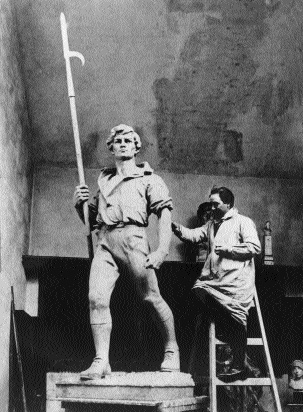
Oliver Sheppard working on the Wexford Pikeman. (National College of Art and Design)
It was not until as late as 1879 that a group of Wexford men living in Dublin founded the ‘98 Club’ with the aim of commemorating the Rebellion. Irish nationalists were well aware of the Irish unionist celebration of Queen Victoria’s diamond jubilee in 1897, and were intent on celebrating the Rebellion with their own ceremonies and the erection of monuments throughout Ireland.
The initiative to set up a 1798 memorial committee came from John O’Leary and the Irish Republican Brotherhood. However, it was the Irish Parliamentary Party which became the main force behind the move to create permanent monuments. John Redmond, MP for Waterford, as leader of the Parnellites at Westminster, backed O’Leary’s committee. A rival group under John Dillon MP was formed, but after much bickering, they amalgamated in March 1898 and planned various demonstrations for the year. The parliamentary nationalists were determined to use the commemorations to consolidate political support. John Redmond exploited this occasion toproject his own political position as leader of the re-united Irish Parliamentary Party by linking the Rebellion with various legislative freedoms achieved during the nineteenth century and the continuing struggle for Home Rule.
Fr. Kavanagh’s ‘Faith and Fatherland’ interpretation
The position of the Catholic Church was central to the popular interpretation of the Rebellion as a fight for ‘Faith and Fatherland’.This was at the opposite pole to the secularist republicanism of theIrish Republican Brotherhood which traced its origins to the Fenians and further back to the Society of United Irishmen and the French Revolution. The Catholic Church in Ireland, as elsewhere, had opposed the revolutionary violence unleashed by the French Revolution, but a century later it viewed the Irish Rebellion of 1798 as a struggle of the Irish Catholic people for their religion against alien oppression.The stress was on the cruelties of the British colonial establishment.A leading propagandist for this romantic, clericalist and nationalist interpretation was Father Patrick Kavanagh, a polemical Franciscan historian. The arguments were largely a reaction against the Irish unionist interpretation of the Rebellion as a manifestation of Catholic sectarian savagery. Kavanagh’s popular history of the rebellion was re-issued several times since the 1870s and formed the interpretation which lay behind the 1798 commemorations in County Wexford. He stressed the role of the church as friend of the people and of heroic priest leaders, like Father John Murphy of Boolavogue.
It is clear that the 1798 centenary celebrations which took place throughout the county had a strongly contemporary political dimension. These were not sentimental commemorations of ‘battles long ago’, but a rallying point for resurgent nationalist opinion in the 1890s, centred on the politicians of the Irish Parliamentary Party and of the local authorities after 1898, together with local newspapers, as organs of mass communication. It was an alliance of Catholic and nationalist forces in asserting the claim of Home Rule for Ireland—an exercise in mass democracy.
Oliver Sheppard
These ideals were embodied in the commemorative memorials of the period, most notably those of Oliver Sheppard in County Wexford. He was born into a Dublin Protestant artisan family in 1865. He studied at the Dublin Metropolitan School of Art (now the National College of Art and Design), at the Royal Hibernian Academy Schools, at the Royal College of Art, London, and finally, in 1891-92, at the Academie Julian in Paris. He was deeply influenced by the new stylistic tendencies in French and British sculpture which he absorbed from the great French teacher, Edouard Lanteri in London. He returned to Ireland as instructor in modelling in 1902, where he became an active participant in the Irish cultural revival and was drawn especially to the poetry of James Clarence Mangan and of W.B. Yeats. During the late 1890s he regularly sent sculptures on themes from Irish poetry and legend, to the exhibitions of the Royal Hibernian Academy. He was sufficiently nationalistic to become a member of the Gaelic Society of the School of Art in 1905. He made a portrait bust of the Fenian, John O’Leary, in 1904, and of Mangan in 1909.
Laying the Wexford foundation stone
On1 November, 1898, Father Kavanagh laid the foundation stone of the Wexford 1798 monument. Kavanagh said that the monument would be proof to future generations that we were imbued with the spirit of the men of ‘98…The men, whose memory we honour today, died for a persecuted creed as well as an oppressed county…Their blood was not poured forth in vain. It made the earth which drank it ever sacred to freedom; with their expiring breath they kindled the embers of a fire which burns still. Kavanagh identified the modern political struggle for self-determination with the monument yet to be erected.
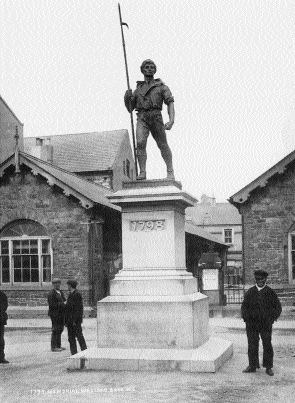
The choice of the Bull Ring for the monument was symbolic. It was there in 1641 that Cromwell, having seized Wexford, killed men and women of the town. A fragment of the former Market Cross was incorporated in the foundations, thus linking the monument to the early Catholic life of the town. It had also been the site of a 1797 munitions factory where blacksmiths worked continuously to forge pikes and repair weapons. The foundation stone came from Three Rocks, site of one of the battles of the Rebellion.
The laying of the foundation stone became a political demonstration. The streets of Wexford were decorated with flags and evergreens, and the parade included horsemen and marching bands. The foundation stone itself was guarded by men dressed as rebel pike men of 1798. Constitutional nationalism was powerfully represented by the presence of four Irish MPs: John and William Redmond, Peter Ffrench and Sir Thomas Grattan Esmond. The main organisers in Wexford were Simon McGuire of the newspaper, The Free Press, who publicised the project.
Oliver Sheppard and his sculptor friend and exact contemporary, John Hughes, were invited to compete for the commission. It went to Hughes, then based in Dublin, who agreed to model the figure, but refused to accept the committee’s time limit, thus forfeiting the commission. When Sheppard returned to Ireland to his new teaching post in July 1902, he was invited to meet the Wexford ‘98 Committee. They told him on 10 September ‘our idea of the monument is a figure…of an insurgent peasant (about seven feet high) with pike in hand and in a defiant attitude’. In defining their ideas, they had theadvice of a local priest.
By October 1902 Sheppard was modelling a small clay study of the figure. He signed a contract which stated that if any dispute arose it was to be referred for arbitration by an architect or engineer appointed by John Redmond or Dr Walsh, Catholic Archbishop of Dublin. It is evident that this entire operation was in the orbit of the parliamentary nationalist and Catholic authorities.
In 1903 Sheppard worked on a quarter-sized model, using a pike-head sent to him by the Wexford committee. Over the summer, he completed a full-scale figure in clay which was cast into plaster. Finally, in August, this plaster cast was sent to Paris to be cast into bronze by E. Gruet. In February 1904 the completed bronze was sent to Ireland. A limestone pedestal was supplied by D. Carroll of Tullamore to Sheppard’s specification. The date ‘1798’ alone was cut in the pedestal, despite the misgivings of some of the committee who wanted a further text in case ‘people would lose sight of the object for which the monument was erected’. The bronze figure was exhibited at the Royal Hibernian Academy, Abbey Street, Dublin, in March 1904, after which it was stored in Wexford Town Hall. In March 1905 the limestone pedestal was put in position in the Bull Ring and the figure set upon it.
Unveiling
Theunveiling on Sunday, 6 August, 1905, was the culmination of the campaign begun in 1898. About 30,000 people attended with excursion trains from Dublin and a group from Liverpool too. The night before, bonfires heralded the event. The Bull Ring was elaborately decorated with festoons and arches. A large outline of the number ‘98’ and pikes crossing was spelled out in gas jets at the gas works. Similar gas-litre presentations of a wolfhound and a round tower were displayed at the Pierce engineering works; on the lamp posts were images of pike men. The day of the unveiling began with an elaborate procession with marching bands from all over the county. It was a spectacular political rally.
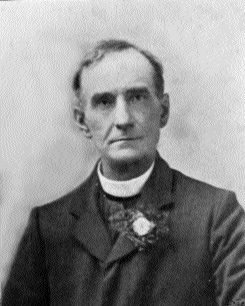
Father Patrick Kavanagh OSF-most influential in promoting a ‘Faith and Fatherland’ interpretation of 1798 for the centenary.
The contemporary relevance of the commemoration was made clear by J. Stafford, Lord Mayor of Wexford, who said ‘it was the duty of everyone claiming to be an Irishman…not to waiver until the aspirations of those brave men [of 1798] had been fulfilled’. There were messages of support from John Redmond, Grattan Esmond and Michael Davitt which indicated that the Irish Parliamentary Party was solidly behind the commemoration and wanted this to be registered publicly.
The bronze was unveiled by Father Kavanagh who said ‘The men of Wexford rose…in defence of their desecrated temples, of their ravaged homes, and were justified before God and man’. Kavanagh’s Faith and Fatherland interpretation found no room for the United Irishmen or the republican ideal. In true romantic nationalist fashion he encouraged Irishmen to keep working until ‘the crown of independence rests once more on the head of our long-suffering queen, our Dark Rosaleen’. Another speaker pushed home the message that Redmond and the Irish Parliamentary Party‘ were waging a terrific fight every day at Westminster against an enemy eight times their strength, and was dealing with the enemy blow for blow in the manner characteristic of ‘98’. Several art reviewers also commented on the bronze. Of these, only Edward Martyn (the playwright and art patron) really understood the meaning of the work as ‘a symbol of an emancipated Ireland marching onward self-reliant in the distinctive character that comes from a distinctive national life’. The figure was thus an emblem of the Irish cultural revival—looking as much to the new Ireland of the future as it was recalling the past.
Enniscorthy
The success of the campaign in Wexford town influenced the memorial committee set up in Enniscorthy. It was at Oulart Hill near Enniscorthy that Father John Murphy had set the insurrection on its course. Enniscorthy was at the heart of the Rebellion, particularly Vinegar Hill, outside the town. The hill was first proposed as a site for the monument, but its owner, Lord Portsmouth, refused permission. It was then decided to place it in the Market Square which had seen bitter fighting in May and June, 1798. In 1905 Sir Thomas Esmond laid the foundation stone and in February the committee advertised for a sculptor. In raising the £800 for the commission the local committee was supported by committees in Dublin, Liverpool and New York. The support from America was particularly important. The Enniscorthy committee entreated Sheppard to make a submission, which he did by April 1905. An edition of 5,000 postcards using a photograph of Sheppard’s sketch was printed to publicise the project and raise money.
The driving force behind the Enniscorthy committee was Father Robert FitzHenry, administrator of St Aidan’s, Enniscorthy, who was a local nationalist historian. He made suggestions to the sculptor to modify the group to enhance its ‘meaning and strength’. Throughout 1906, Sheppard worked on the full-size model in his studio at 30 Pembroke Road, Dublin, assisted by the young sculptor, Albert Power. An Enniscorthy delegation came to his studio to inspect the progress of the work in May 1907. The bronze was cast by the Compagnie des Bronzes, Brussels, later that year and was completed by February 1908.
The unveiling took place on Sunday, 31 May, 1908. There was the normal big parade with an attendance of 20,000 people, many of whom came on special trains. The unveiling was performed once again by Father Kavanagh. He had a personal interest since he was grand-nephew of Father Michael Murphy, killed in action at the battle of Arklow. Kavanagh spoke forcibly on his usual themes. He praised the men who haddied for their ‘dear native land—in defence of her sacred altars and cherished homes’. He pointed to the contemporary lessons of the Rebellion—that Ireland must be a ‘self-governing nation…This Irish land belongs to the Irish race, whose ownership goes back to a remote period of the world’s history’. He castigated the Act of Union when the old Irish parliament was ‘so treacherously and basely filched from her people’. When he concluded the band played ‘Who Fears to Speak of 98’, ‘A Nation Once Again’, and ‘God Save Ireland’, with the crowd joining in song.
As in Wexford before, the Irish Parliamentary Party used the campaign and unveiling to marshal support for the Home Rule cause. William Redmond astutely linked the Rebellion of 1798 with various political improvements of the nineteenth century: ‘The aspiration of the patriots of ‘98 must be satisfied, and a full measure of national freedom must be granted to Ireland.’ Unlike Kavanagh,Redmond gave full credit to the United Irishmen which would have appealed to the more radical voters among the supporters of the Irish Parliamentary Party. Father FitzHenry reiterated the contemporary Catholic church view when he referred to Sheppard’s two-figure group:
It was particularly fitting that a priest and a peasant should stand together united as they stood… when they fought side-by-side for faith and fatherland…It was God’s decree that the people of Ireland should be allowed to carry out their own affairs without any interference from anyone.
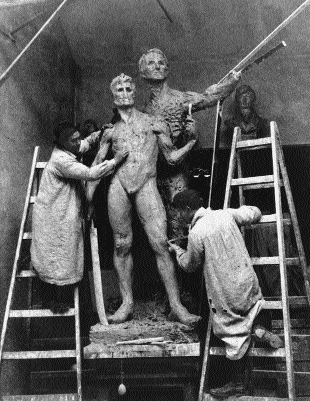
Oliver Sheppard, assisted by Albert Power, working on the Enniscorthy group. (National College of Art and Design)
There was only one discordant note. Mr McAleavy of Liverpool said that he supported Sinn Féin ‘but he was not going to run down the Irish Party’. The day concluded with dinner when Sheppard was thanked and handed a cheque for the balance owing.
The cult of Father John Murphy
The Enniscorthy memorial with two figures is more complex than the Wexford one. It shows Father John Murphy, the patriot-priest, with a young man with banner and home-made sword. The cult of Father John Murphy owed agreat deal to the polemical writing of Father Kavanagh who described him as ‘the idol of the brave men whom he led, and who admired in him the projection of their own courage’. The Enniscorthy monument commemorates the Rebellion as a religious crusade against anti-Catholic oppression. The orthodox piety of Father Murphy is emphasised by the rosary beads hanging from his pocket. (The Rosary was a popular Catholic devotion of 1898, rather than 1798.) The strong clerical element in the organising committee ensured the dominance of this interpretation.
In these two monuments by Sheppard the 1798 Rebellion was viewed as a morally righteous rising by devout Catholic people, led by Catholic clergy, fighting for their religion and their country, against the Godless English enemy. All the complexities of the 1790s were ruthlessly compressed with this simplified, historically skewed, but extremely popular and powerful interpretation at the centenary. The actual French Revolution was detested by the Irish Catholic bishops in 1798 and again in 1898 when anti-clericalism in France was still very strong. In Ireland, the devotion to the Catholic church by Irish farmers, now gradually acquiring ownership of their land, was the bedrock on which the monuments were founded. The relative size of priest and pike man at Enniscorthy, with one clearly the leader pointing the way, and the other the follower, bearing the standard, were symbolic of this Catholic political strategy.
Manifestations of modernity
It is also worth noting that the heroic idealisation of vigorous young men in warlike poses places those monuments in the larger context of war memorials. In another sense the sturdy young peasants in Sheppard’s memorials in Wexford can be seen as a social protest of the tenant farmer against the old land-owning classes, already in retreat by the 1900s. Various aspects of modernity were also manifested in these sculptural projects: mass communications—newspapers to publicise the commissions and raise funds, steamers to transport the plasters and bronzes between Ireland and the continent, and finally, excursion trains and gas illuminations to contribute to the popular spectacle of the unveiling with the mass political rallies.
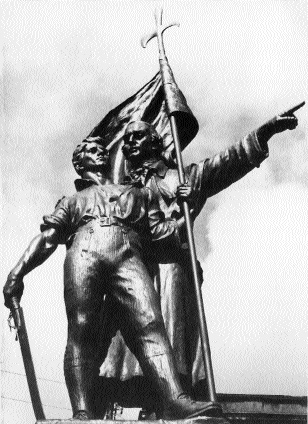
In the Enniscorthy monument, Father John Murphy points the way for the young insurgent.
The primary meaning of these two monuments, when they were commissioned, related to the realities of local power in County Wexford. The new local authorities now controlled town and county affairs for the first time.The reunited Irish Parliamentary Party under John Redmond, with the support of his brother William, dominated local political life. With the Liberal Party back in power in London since 1906 the prospects of Home Rule had greatly improved. The Catholic church, secure now in its dominant social position, supported these political aims under its own moral leadership.
Deep ambiguity
However, constitutional nationalists preferred to ignore the deep ambiguity of these monuments which clearly commemorate a violent and bloody popular rising. The Catholic church preferred to ignore the secularist republicanism. The presence of these physically large, dramatic and forceful monuments pointed to the possibility of using violence again to solve Ireland’s political problems. While constitutional nationalism provided the drive behind the creation of these monuments, ironically it was the tradition of physical force, implicit in all the 1798 commemorations, including Sheppard’s figures, which ultimately benefited most. This in turn swept away the Irish Parliamentary Party. The sculptures are multi-faceted and have a resonance greater than the narrow intentions of those who commissioned them at the centenary.
John Turpin is Professor of History of Art at the National College of Art and Design, Dublin.
Further reading:
J. Turpin, ‘Oliver Sheppard’s 1798 Memorials’ in Irish Arts Review (1990-91 yearbook).
J. Hill, Irish Public Sculpture (Dublin 1998).
















